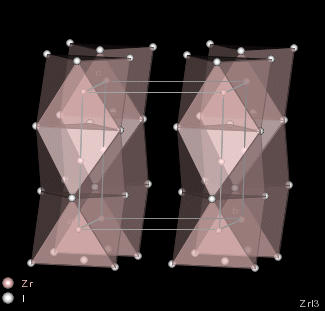博文
Build intuition之: 常见晶体结构类型再谈
||
关注:
1)Pearson symbol标记
2) typical 或well known结构
参考网址:
!! http://jcrystal.com/steffenweber/gallery/StructureTypes/st4.html
http://icsd.ill.eu/icsd/help/structuret.html
该网站给出了Structure type,Space Group, Wyckoff Symbol, Pearson Symbol 等十分有用的信息,如
| Structure Type | Prototype CC Code | Space Group | SG Num. | ANX Form. | Wyckoff Symbol | Pearson Symbol | c/a Min | c/a Max | AET | Pearson Note | Description |
| (Bi7Pb)Pt4 | 58336 | PNMA | c3 | oP12 | 2 | 2.5 |
| CeF3 | 4 | P3-c1 | g f d a | hP24 | LaF3, Cu3P, HoH3, tysonite | ||||||
| CeMn6Ni5 | 102223 | P4/MBM | k j g c a | tP24 | 0.50 | 0.90 | U(Ni.68Si.32)11 | tP24, P4/mbm, 1.5-1.9, k j g c a, 102223 | |||
| CeNi12B6 | 60771 | Cmc21 | 36 | b7 a5 | oS76 | ||||||
| CeNi3 | 102230 | P63/MMC | k f d c b a | hP24 | 2.90 | 3.80 |
| LaF3(P63mc) | 27089 | P63cm | c3 b a | hP24 |
| YF3 | 26595 | PBNM | AX3 | d c2 | oP16 | 1.00 | 1.25 | ||||
| YF3 | 26595 | PNMA | AX3 | d c2 | oP16 | 0.60 | 0.80 | "isopointal with Fe3C AX3, must contain F, Cl, Br oder I enthalten" |
| Al3Pu | 58141 | P63/mmc | 194 | k h f b | hP24 | 2.2 | 2.5 |
| Na3As | 26883 | P63/MMC | f c b | hP8 | 1.55 | 2.00 | Al3Ir, SB: D0(18) | ||||
| Na3As | 26883 | P63/MMC | f d b | hP8 | 1.55 | 2.00 | Al3Ir, SB: D0(18) |
| Ni3Sn | 105357 | P63/MMC | h c | hP8 | 0.70 | 0.90 | Mg3Cd, Pt3U, SB: D0(19) | Aristotype is Mg | |||
| Ni3Sn | 105357 | P63/MMC | h d | hP8 | 0.70 | 0.90 | Mg3Cd, Pt3U, SB: D0(19) | Aristotype is Mg |
| Ni3Ti | 30216 | P63/MMC | h g c a | hP16 | 1.45 | 1.85 | Pd3U, SB: D0(24) | D0(24)-Type | |||
| Ni3Ti | 30216 | P63/MMC | h g d a | hP16 | 1.45 | 1.85 | Pd3U, SB: D0(24) |
题记:Thanks to Huayun
In the PBE calculations, we tried to include all possible candidates for post-cotunnite phases, and the following structures were considered:
fluorite(space group Fm-3m, Z = 4),
cotunnite (Pnma, Z= 4),
pyrite or modified fluorite (Pa-3,Z = 4),1
brookite (Pbca, Z= 8),1[H2O2的相]
post-PbCl2 (P1121/aor P21/a, Z = 8),
2 -US2 or Fe2P (P62m, Z = 3),3–6
post-cotunnite phase of TeO2(P21/m, Z = 4),7,8
Co2Si (Pnma, Z = 4),9
Ni2In or _-Ni2Si (P63/mmc, Z = 2),3,10–13
distorted Ni2In (Cmcm, Z = 4),3and
AlB2(P6/mmm, Z =1).14
The Cmc21 (Z =4, CN= 11) and P63mc (Z =2, CN= 11)phases
were captured by the structural search in PSO evolutionary calculations.S
imilar to Cmcm phase, both of these two structures are also adistortion of the hexagonal Ni2In phase
post-cotunnite phases
cotunnite (Pnma, Z= 4)
brookite (Pbca, Z= 8),
板钛矿
The brookite structure is built up of distorted octahedra with a titaniumion at the center and oxygen ions at each of the six vertices. Each octahedron shares three edges with adjoining octahedra, forming an orthorhombic structure.[8]
Brookite is orthorhombic, and one of the four naturally occurring polymorphs (minerals with the same composition but different structure) of titanium dioxide, TiO2, approved by the International Mineralogical Association (IMA). The others are akaogiite (monoclinic), anatase (tetragonal) and rutile (tetragonal). Brookite is rare compared to anatase and rutile and, like these forms, it exhibits photocatalytic activity.[5] Brookite has a larger cell volume than either anatase or rutile, with 8 TiO2 groups per unit cell, compared with 4 for anatase and 2 for rutile.[6]Iron Fe, tantalum Ta and niobium Nb are common impurities.[3]
pyrite or modified fluorite (Pa-3,Z = 4),FeS2 type
http://en.wikipedia.org/wiki/Pyrite
黄铁矿 Space group: Pa3
Crystallography[edit]
Iron-pyrite FeS2 represents the prototype compound of the crystallographic pyrite structure.
The structure is simple cubic and was among the first crystal structures solved by X-ray diffraction.
[22] It belongs to the crystallographic space groupPa3 and is denoted by the Strukturbericht notation C2.
Under thermodynamic standard conditions the lattice constant of stoichiometric iron pyrite FeS2 amounts to 541.87 pm.[23]
of stoichiometric iron pyrite FeS2 amounts to 541.87 pm.[23]
The unit cell is composed of a Fe face-centered cubic sublattice into which the S ions are embedded.
The pyrite structure is also used by other compounds MX2 of transition metalsM and chalcogensX = O, S, Se and Te. Also certain dipnictides with X standing for P, As and Sb etc. are known to adopt the pyrite structure.[24]
In the first bonding sphere, the Fe atoms are surrounded by six S nearest neighbours, in a distorted octahedral arrangement. The material is a diamagneticsemiconductor and the Fe ions should be considered to be in a low spindivalent state (as shown by Mössbauer spectroscopy as well as XPS), rather than a tetravalent state as the stoichiometry would suggest.
The positions of X ions in the pyrite structure may be derived from the fluorite structure, starting from a hypothetical Fe2+(S−)2 structure.
Whereas F− ions in CaF2 occupy the centre positions of the eight subcubes of the cubic unit cell (¼ ¼ ¼) etc., the S− ions in FeS2 are shifted from these high symmetry positions along <111> axes to reside on (uuu) and symmetry-equivalent positions. Here, the parameter u should be regarded as a free atomic parameter that takes different values in different pyrite-structure compounds (iron pyrite FeS2: u(S) = 0.385 [25]).
The shift from fluorite u = 0.25 to pyrite u = 0.385 is rather large and creates a S-S distance that is clearly a binding one. This is not surprising as in contrast to F− an ion S− is not a closed shell species. It is isoelectronic with a chlorine atom, also undergoing pairing to form Cl2 molecules. Both low spin Fe2+ and the disulfide S22− moeties are closed shell entities, explaining the diamagnetic and semiconducting properties.
The S atoms have bonds with three Fe and one other S atom. The site symmetry at Fe and S positions is accounted for by point symmetry groupsC3i and C3, respectively. The missing center of inversion at S lattice sites has important consequences for the crystallographic and physical properties of iron pyrite. These consequences derive from the crystal electric field active at the sulfur lattice site, which causes a polarisation of S ions in the pyrite lattice.[26] The polarisation can be calculated on the basis of higher-order Madelung constants and has to be included in the calculation of the lattice energy by using a generalised Born–Haber cycle. This reflects the fact that the covalent bond in the sulfur pair is inadequately accounted for by a strictly ionic treatment.
Arsenopyrite has a related structure with heteroatomic As-S pairs rather than homoatomic ones. Marcasite also possesses homoatomic anion pairs, but the arrangement of the metal and diatomic anions is different from that of pyrite. Despite its name a chalcopyrite does not contain dianion pairs, but single S2− sulfide anions.
Crystal habit[edit]
Pyrite usually forms cuboid crystals, sometimes forming in close association to form raspberry-like framboids. However, under certain circumstances, it can form anastamozing filaments or T-shaped crystals.[27] Pyrite can also form dodecahedral crystals and this suggests an explanation for the artificial geometrical models found in Europe as early as the 5th century BC.[28]
Varieties[edit]
Cattierite (CoS2) and vaesite (NiS2) are similar in their structure and belong also to the pyrite group.
Bravoite is a nickel-cobalt bearing variety of pyrite, with > 50% substitution of Ni2+ for Fe2+ within pyrite. Bravoite is not a formally recognised mineral, and is named after Peruvian scientist Jose J. Bravo (1874–1928).[29]
post-PbCl2 (P1121/aor P21/a, Z = 8),
γ-US2 or Fe2P (P62m, Z = 3)
post-cotunnite phaseof TeO2(P21/m, Z = 4)
Co2Si(Pnma, Z =4)
Ni2In or θ-Ni2Si (P63/mmc, Z = 2)
distortedNi2In (Cmcm, Z = 4)
a distortion of the hexagonal Ni2In phase:AlB2(P6/mmm, Z = 1)
a distortion of the hexagonal Ni2In phase:Cmc21(Z =4, CN= 11)
BiF3结构
α-BiF3属于立方晶系结构(皮尔逊符号:cF16,空间群:Fm-3m, No. 225)。
β-BiF3具有YF3型结构,其中铋原子采取了变形的9配位三冠三棱柱构型。[4]这种结构一般被认为是离子型的,与同族其他元素的三氟化物不同。因为三氟化磷(PF3)、三氟化砷(AsF3)和三氟化锑(SbF3)中固态时都存在着MX3分子。[4]
| 晶体结构 | 正交晶系,oP16,空间群:Pnma, No. 62(β相) |
plumbum
http://en.wikipedia.org/wiki/Barium_chloride
BaCl2 crystallizes in two forms (polymorphs). One form has the cubicfluorite (CaF2) structure and the other the orthorhombiccotunnite (PbCl2) structure. Both polymorphs accommodate the preference of the large Ba2+ ion for coordination numbers greater than six.[4] The coordination of Ba2+ is 8 in the fluorite structure[5] and 9 in the cotunnite structure.[6] When cotunnite-structure BaCl2 is subjected to pressures of 7–10 GPa, it transforms to a third structure, a monoclinic post-cotunnite phase. The coordination number of Ba2+ increases from 9 to 10.[7]
PbCl2 adopt the cotunnite structure (Pnam, Z = 4)
参考网址:
http://www.sciencedirect.com/science/article/pii/0022369795000607
The high pressure behaviour of PbCl2 and SnCl2 has been investigated by angular-dispersive X-ray diffraction.
Under ambient conditions, these two compounds adopt the cotunnite structure (Pnam, Z = 4) for which the cation has the highest coordination number found among the ionic AX2 compounds.
A crystallographic transition was observed at 16 GPa for both compounds. The structure of the high pressure phase is a distorted orthorhombic Co2Si structure: it is monoclinic (![]() &lt;img height="30" border="0" style="vertical-align:bottom" width="62" alt="" title="" src="http://origin-ars.els-cdn.com/content/image/1-s2.0-0022369795000607-si1.gif"&gt;, Z = 8) and the coordination number has increased to ten.
&lt;img height="30" border="0" style="vertical-align:bottom" width="62" alt="" title="" src="http://origin-ars.els-cdn.com/content/image/1-s2.0-0022369795000607-si1.gif"&gt;, Z = 8) and the coordination number has increased to ten.
The mechanism of the transition occurs in two minimal steps: &lt;img height="50" border="0" style="vertical-align:bottom" width="190" alt="" title="" src="http://origin-ars.els-cdn.com/content/image/1-s2.0-0022369795000607-si2.gif"&gt;. The pressure dependence of the cell constants, volume and the equation-of-state parameters are given.
In the cotunnite phase, B0 and B0′ are 34 GPa and 7.4, and 31 GPa and 4.9, for PbCl2 and SnCl2, respectively. The bulk moduli of both compounds triple above the transition.
The same monoclinic structure accounts for the high pressure phases of all the cotunnite-structured compounds investigated up to now.
This structure type was previously unknown for AX2 compounds and is now the final step for the high pressure sequence of the phase transitions in these compounds. It is probable that the AO2 dioxides adopt this structure in the megabar range.
Theoretical and experimental evidence for a new post-cotunnite phase of titanium dioxide with significant optical absorption.
We report the discovery of a post-cotunnite phase of TiO2 by both density-functional ab initio calculations and high-pressure experiments.
A pressure-induced phase transition to a hexagonal Fe2P-type structure (space group P62m) was predicted to occur at 161 GPa and 0 K and successfully observed by in situ synchrotron x-ray diffraction measurements at 210 GPa and 4000 K with a significant increase in opacity.
This change in opacity is attributed to a reduction of band gap from 3.0 to 1.9 eV across the phase change. The Fe2P-type structure is proved to be the densest phase in major metal dioxides.
三氧化铼结构
化合物的晶体结构[编辑]
参考网址:http://zh.wikipedia.org/wiki/%E6%99%B6%E4%BD%93%E7%BB%93%E6%9E%84
| 名称 | 英文名 | 代号 | 晶格结构 | 晶系 | 配位 | 举例 | 示意图(点击可放大) |
|---|---|---|---|---|---|---|---|
| 氯化钠结构 | NaCl structure | B1型 | 面心立方晶格 | 立方晶系 | [6] | [7] |  |
| 氯化铯结构 | CsCl structure | B2型 | 简单立方晶格 | 立方晶系 | [8] | [9] |  |
| 立方硫化锌(闪锌矿)结构 | zinc blende structure | B3型 | 类金刚石晶格 | 立方晶系 | [10] | [11] |  |
| 六方硫化锌(纤锌矿)结构 | wurtzite structure | B4型 | 简单六方晶格 | 六方晶系 | [12] | [13] |  |
| 砷化镍结构 | NiAs structure | B8型 | 六方晶系 | [14] | [15] | 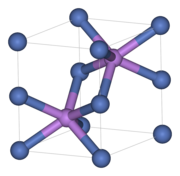 | |
| 碘化镉结构 | CdI2 structure | C6型 | 三方晶系 |  | |||
| 萤石结构 | fluorite structure | C1型 | 面心立方晶格 | 立方晶系 | 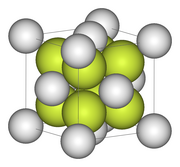 | ||
| 反萤石结构 | antifluorite structure | C2型 | 立方晶系 |  | |||
| 金红石结构 | rutile structure | C4型 | 简单四方晶格 | 四方晶系 | 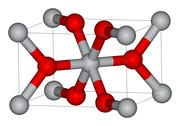 | ||
| 钙钛矿结构 | perovskite structure | E21型 | 立方晶系 | 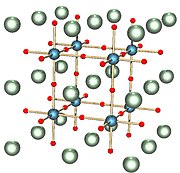 | |||
| 三氧化铼结构 | ReO3 structure | DO9 | 立方晶系 |  |
1.Pearson symbol标记
http://zh.wikipedia.org/wiki/皮尔逊符号
皮尔逊符号(英语:Pearson symbol)又称皮尔逊记号,是晶体学中描述晶体结构的一种方法,由里奥·布鲁尔·皮尔逊创立。[1]这种符号由两个字母和一个数字组成,例如:
根据2005年IUPAC无机化学命名法,两个斜体字母具体指定布拉维点阵,其中小写字母表明晶体的类型,大写字母表明点阵的类型。最后的数字表示一个晶胞内原子的个数。[2]
符号对照表[编辑]
| a | 三斜 |
| m | 单斜 |
| o | 正交 |
| t | 四方 |
| h | 六方和三方 |
| c | 立方 |
| C | 侧面心 |
| F | 面心 |
| I | 体心 |
| R | 菱方 |
| P | 简单 |
十四种可能的布拉维点阵可以通过前两个字母来区别:
| 晶族 | 点阵符号 | 皮尔逊符号的字母 |
|---|---|---|
| 三斜 | P | aP |
| 单斜 | P | mP |
| 单斜 | C | mC |
| 正交 | P | oP |
| 正交 | C | oC |
| 正交 | F | oF |
| 正交 | I | oI |
| 四方 | P | tP |
| 四方 | I | tI |
| 六方和三方 | P | hP |
| 菱方 | R | hR |
| 立方 | P | cP |
| 立方 | F | cF |
| 立方 | I | cI |
皮尔逊符号和空间群[编辑]
皮尔逊符号不能唯一地表示晶体结构的空间群,例如氯化钠型结构(空间群:Fm3m)和金刚石型结构(空间群:Fd3m)的皮尔逊符号都是cF8。
2. 英文介绍
The Pearson symbol, or Pearson notation, is used in crystallography as a means of describing a crystal structure, and was originated by W.B. Pearson.[1]
The symbol is made up of two letters followed by a number. For example:
Diamond structure, cF8
Rutile structure, tP6
The two (italicised) letters specify the Bravais lattice.
The lower case letter specifies the crystal class, and
the upper case letter the lattice type.
The figure gives the number of the atoms in the unit cell. IUPAC (2005) [2]
| a | triclinic |
| m | monoclinic |
| o | orthorhombic |
| t | tetragonal |
| h | hexagonal and rhombohedral |
| c | cubic |
| S,A,B,C | Side face centred |
| F | All face centred |
| I | Body centred (from innenzentrierte (German))[3] |
| R | Rhombohedral |
| P | Primitive |
The letters A, B and C was formerly used instead of S. When centering had a pair of opposite faces along the X-axis it was called A-centered. Equivalent centering along the Y- and Z-axes were called B- and C-centered, respective.[3]
The fourteen possible Bravais lattices are identified by the first two letters:
| Crystal class | Lattice symbol | Pearson symbol letters |
|---|---|---|
| Triclinic | P | aP |
| Monoclinic | P | mP |
| S | mS | |
| Orthorhombic | P | oP |
| S | oS | |
| F | oF | |
| I | oI | |
| Tetragonal | P | tP |
| I | tI | |
| Hexagonal (and trigonal) | P | hP |
| Rhombohedral | R | hR |
| Cubic | P | cP |
| F | cF | |
| I | cI |
Pearson symbol and space group[edit]
The Pearson symbol does not uniquely identify the space group of a crystal structure, for example both the NaCl structure, (space group Fm3m) and diamond (space group Fd3m) have the same Pearson symbol cF8.
References[edit]
^ W.B. Pearson, A Handbook of Lattice Spacings and Structures of Metals and Alloys,Vol. 2, Pergamon Press, Oxford, 1967
^ Nomenclature of Inorganic Chemistry IUPAC Recommendations 2005; IR-3.4.4, pp.49-51; IR-11.5, pp.241-242
^ a b page 124 in chapter 3. Crystallography: Internal order and symmetry in Cornelius Klein & Cornelius S. Hurlbut, Jr.: Manual of Mineralogy, 21st edition, 1993, John Wiley & Sons, Inc., ISBN 0-471-59955-7
Further reading[edit]
2. Cu3As arrangement -----I-43d
Nb3Sn-type ---- Pm-3n
http://jcrystal.com/steffenweber/gallery/StructureTypes/st4.html
|
| V F3 R-3c (167) [hR8] |
|
| Zr I3 P63/mcm (193) [hP8] |
https://blog.sciencenet.cn/blog-567091-738807.html
上一篇:Build intuition之晶体中四面体间隙和八面体间隙
下一篇:Build intuition: 从氢化物开始






